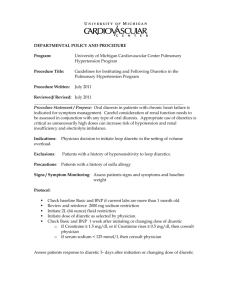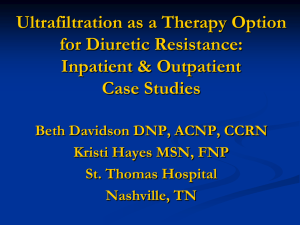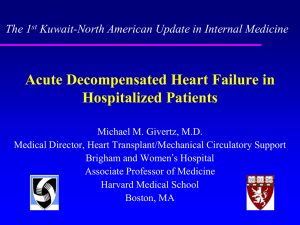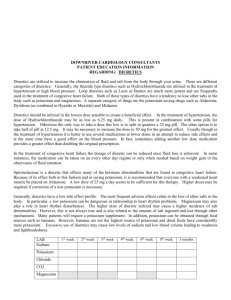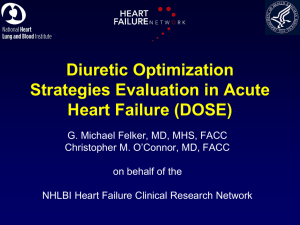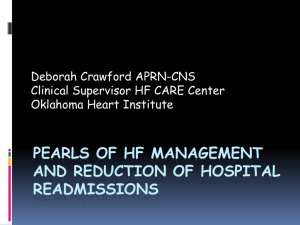Diuretics or Ultrafiltration?
advertisement
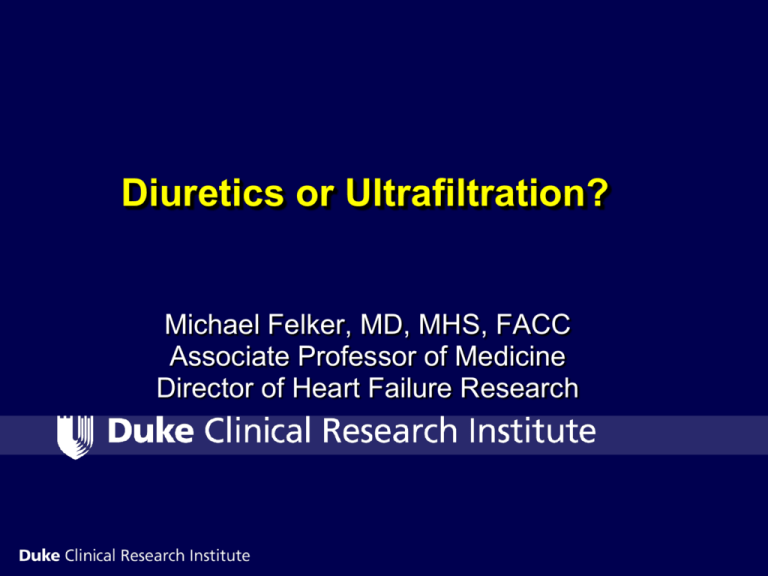
Diuretics or Ultrafiltration? Michael Felker, MD, MHS, FACC Associate Professor of Medicine Director of Heart Failure Research Disclosures n I take no diuretics n I own no diuretic stock n I have no patents related to diuretics n I am not a consultant for the furosemide medical-industrial complex Congestion is the Main Cause of HF Hospitalizations 6% 2% N=3580 9% 53% 30% Decomp. HF Pulm. Edema HTN HF Cardiogenic shock RHF Nieminen, M et al Eur Heart J 2006 Congestion is both Cause and Effect Worsening HF Spherical LV geometry Sub-endocardial Ischemia Functional MR Elevated LVEDP How Successful Are We at Addressing Congestion? 33% 35 Patients (%) 30 24% 25 20 13% 15 10 7% 15% 6% 5 3% 2% (5 to 10) (>10) 0 (<-20) (-20 to -15) (-15 to -10) (-10 to -5) (-5 to 0) (0 to 5) Change in Weight (lbs) Fonarow GC. Rev Cardiovasc Med. 2003 Traditional Approaches to Congestion in HF? Current Guidelines on Diuretics in ADHF Class I. Patients admitted with ADHF and significant volume overload should be treated with IV loop diuretics. Therapy should begin in ED or outpt clinic without delay. If patients are already receiving loop diuretic therapy, the IV dose should equal or exceed their chronic oral daily dose. Diuretic dose should be titrated to relieve symptoms and reduce extracellular fluid excess (Level of Evidence C). Jessup M et al, Circulation 2009 Diuretics in ADHF n IV loop diuretics are the mainstay of therapy for ADHF (given to ≈90% of patients) n Relieve symptoms of dyspnea and edema in most patients n Associated with a variety of potential problems l Electrolyte abnormalities l Activation of RAAS and SNS l Diuretic resistance l Structural changes in distal tubule l Worsening renal function l Increased mortality? Diuretic Resistance in HF n n Heart failure and CKD are both associated with relative diuretic resistance “Braking Phenomenon” l n A decrease in response to a diuretic after the first dose has been administered Long-term Tolerance l Tubular hypertrophy to compensate for salt loss Brater DC. N Engl J Med. 1998;339:387, Ellison, Cardiology 2001 Mortality by Diuretic Dose: Data From ESCAPE 0.50 0.45 0.40 Mortality Mortality 0.35 0.30 0.25 0.20 0.15 0.10 0.05 0.00 0 100 200 300 400 500 600 700 Maximum in-hospital In-hospital Diuretic Maximum diureticDose dose Predicted Observed Hasselblad et al. Eur J Heart Fail. 2007;9:1064. Felker GM et al, NEJM 2011 Study Design Acute Heart Failure (1 symptom AND 1 sign) <24 hours after admission 2x2 factorial randomization Low Dose (1 x oral) Q12 IV bolus Low Dose (1 x oral) Continuous infusion High Dose (2.5 x oral) Q12 IV bolus 48 hours 1) Change to oral diuretics 2) continue current strategy 3) 50% increase in dose 72 hours Co-primary endpoints 60 days Clinical endpoints High Dose (2.5 x oral) Continuous infusion Patient Global Assessment VAS AUC: Q12 vs. Continuous Pt Global Assessment by VAS 100 Q12 Continuous 90 Q12 VAS AUC, mean (SD) = 4236 (1440) 80 Continuous VAS AUC, mean (SD) = 4373 (1404) 70 P = 0.47 60 50 40 30 20 10 0 0 10 Felker GM et al, NEJM 2011 20 30 40 Hours 50 60 70 Patient Global Assessment VAS AUC: Low vs. High Intensification Low Pt Global Assessment by VAS 100 High 90 Low VAS AUC, mean (SD) = 4171 (1436) 80 High VAS AUC, mean (SD) = 4430 (1401) 70 P = 0.06 60 50 40 30 20 10 0 0 10 Felker GM et al, NEJM 2011 20 30 40 Hours 50 60 70 Change in Creatinine at 72 hours Change in Creatinine (mg/dL) 0.15 p = 0.45 p = 0.21 0.1 0.08 0.07 0.05 0.05 0.04 0 Felker GM et al, NEJM 2011 Q12 Continuous Low High Secondary Endpoints: Low vs. High Intensification Low High P value Dyspnea VAS AUC at 72 hours 4478 4668 0.041 % free from congestion at 72 hrs 11% 18% 0.091 -6.1 lbs -8.7 lbs 0.011 3575 mL 4899 mL 0.001 Change in NTproBNP at 72 hrs (pg/mL) -1194 -1882 0.06 % Treatment failure 37% 40% 0.56 % with Cr increase > 0.3 mg/dL within 72 hrs 14% 23% 0.041 6 5 0.55 Change in weight at 72 hrs Net volume loss at 72 hrs Length of stay, days (median) Felker GM et al, NEJM 2011 Changes in Renal Function over Time: Low vs. High Low High Cystatin C 0.1 0.08 0.06 0.04 0.02 0 0 10 20 30 40 50 60 Change in Cystatin C (pg/dL) Change in Creatinine (mg/dL) Creatinine 0.25 0.2 0.15 0.1 0.05 0 0 Days 10 20 30 Days P > 0.05 for all timepoints 40 50 60 Death, Rehospitalization, or ED Visit HR for Continuous vs. Q12 = 1.15 95% CI 0.83, 1.60, p = 0.41 0.5 Continuous Proportion with Death, Rehosp, or ED visit Proportion with Death, Rehosp, or ED Visit 0.6 Q12 0.4 0.3 0.2 0.1 0 0 10 20 30 Days Felker GM et al, NEJM 2011 40 50 60 HR for High vs. Low = 0.83 95% CI 0.60, 1.16, p = 0.28 0.6 High 0.5 Low 0.4 0.3 0.2 0.1 0 0 10 20 30 Days 40 50 60 Take Home from DOSE • No advantage of infusion over bolus • Suggestion of greater decongestion in higher dose at cost of transient changes in renal function • No evidence of longer term harm from higher doses Ultrafiltration as a Therapy for Congestion? n Removes both sodium and free water n Allows for titration of rate of fluid removal to match plasma refill rate n Allows for reduction in diuretic use Simplified Veno-Venous Ultrafiltration Access 0.12 m2 polysulphone filter Return Blood flow adjustable (10-40 ml/minute) Total extracorporeal blood volume 33 ml Peripheral, midline, or central venous access Anticoagulation with heparin recommended Effluent Costanzo MR et al. J Am Coll Cardiol 2007 Primary End Points n Efficacy • Weight loss at 48 hours after randomization • Dyspnea score at 48 hours after randomization n Safety • Changes in serum blood urea nitrogen, creatinine, and electrolytes at 8, 24, 48 and 72 hours after randomization, discharge, 10, 30 and 90 days • Episodes of hypotension during the first 48 hours after randomization UNLOAD: Weight Loss at 48 Hours (Co-Primary) 6 Weight loss (kg) P=0.001 5 4 3 m=5.0, CI ± 0.68 kg (N=83) 2 m=3.1, CI ± 0.75 kg (N=84) 1 0 Ultrafiltration arm Standard care arm Costanzo MR et al. J Am Coll Cardiol 2007 UNLOAD: Dyspnea Score at 48 Hours (co-primary) 7 P=0.35 Dyspnea score 6 5 m=6.4, CI ± 0.11 (N=80) 4 m=6.1, CI ± 0.15 (N=83) 3 2 1 Ultrafiltration arm Standard care arm Costanzo MR et al. J Am Coll Cardiol 2007 Percentage of patients free from rehospitalization UNLOAD: Heart Failure Rehospitalization 100 Ultrafiltration arm (16 events) 80 60 Standard care arm (28 events) 40 P=0.037 20 0 0 10 20 30 40 50 60 70 80 90 Days No. of Patients at Risk Ultrafiltration arm 88 85 80 77 75 72 70 66 64 45 Standard care arm 86 83 77 74 66 63 59 58 52 41 Costanzo MR et al. J Am Coll Cardiol 2007 Current Guidelines on Ultrafiltration Class IIa: Ultrafiltration is reasonable for patients with refractory congestion not responding to medical therapy (Level of Evidence B) Jessup M et al, Circulation 2009 Persistent vs. Transient Worsening Renal Function Aronson et al. J Card Failure 2010 Successful Decongestion Critical To Success Testani, J. M. et al. Circulation 2010;122:265-272 Conclusions and Next Steps n Decongestion is important by whatever means n Transient worsening of renal function may be less important than previously thought? n Who are the right patients for UF? l Patients with rising CRS? (CARRESS) l Patients with high likelihood of diuretic resistance? n Role of other adjunctive therapies? l Sequential nephron blockade with thiazides? l “renal dose” dopamine or nesiritide (ROSE) l Short term tolvaptan (TACTICS)
